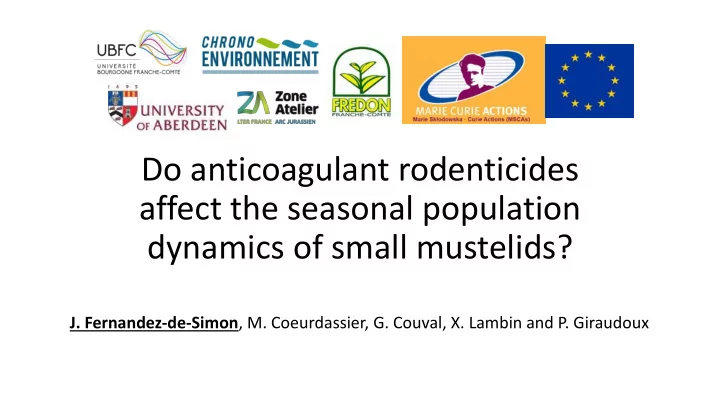

Do anticoagulant rodenticides affect the seasonal population dynamics of small mustelids? J. Fernandez-de-Simon , M. Coeurdassier, G. Couval, X. Lambin and P. Giraudoux
Introduction 5-6 years Vole density time Vole populations show cyclic fluctuations producing strong damages in agriculture properties (1) (1) Delattre and Giraudoux (2009)
Introduction Human-Wildlife Conflict: Anticoagulant rodenticides are used to control small mammals but these are also important for predators (2) (2) Delibes-Mateos et al. (2011)
Introduction Voles controlled with anticoagulant rodenticides can indirectly poison predators (3, 4). Foxes in Franche-Comté (5) Are there any effects at the population level? Stoats in New Zealand (6) (3) Grolleau et al. (1989), (4) Coeurdassier et al. (2014), (5) Jacquot et al. (2013), (6) Murphy et al. (1998)
Introduction Objective: To study if bromadiolone affects small mustelid populations. Hypothesis: Bromadiolone decrease mustelid population change. Prediction: - Mustelid population decrease at treated sites. - Conditional to food availability (water voles).
Methods. Selection of study sites = High frequency of use of bromadiolone (4 sites) = Low frequency or no use of bromadiolone (6 sites) Data of bromadiolone treatment by (7) (7) Jacquot et al. (2013)
Methods. Estimation of small mustelid abundance Surveyed for each site in: - Spring 2016 - Autumn 2016 50 footprint tracking tunnels Seasonal population change = Ln (Autumn / Spring footprints) per site (8) (8) King and Edgar (1977)
Methods. Estimation of vole density Estimation of density by conducting transects on foot, 6 agricultural parcels per site (9) % of sections with presence of water voles (9) Giraudoux et al. (1995)
Data analyses Linear model of variables related to mustelid dynamics Response: Seasonal population change Predictors: - Treatment frequency (High/Low) - Vole density (log-transformed) - Treatment frequency * Vole density P-value of model and variables; R 2
Results: bromadiolone Bromadiolone use in 2016 for sites with high frequency of treatment Bromadiolone (kgs.) Bromadiolone (kgs.) FUANS GILLEY 600 600 400 400 200 200 0 0 Jan-16 Mar-16 May-16 Jul-16 Sep-16 Nov-16 Jan-16 Mar-16 May-16 Jul-16 Sep-16 Nov-16 Repeated treatment, autumn peak Repeated treatment, summer peak
Results: bromadiolone Bromadiolone use in 2016 for sites with high frequency of treatment HAUTEPIERRE BOUJAILLES Bromadiolone (kgs.) Bromadiolone (kgs.) 600 600 400 400 200 200 0 0 Jan-16 Mar-16 May-16 Jul-16 Sep-16 Nov-16 Jan-16 Mar-16 May-16 Jul-16 Sep-16 Nov-16 Repeatedly, Spring treatment peak Treatment only in Autumn
Results: small mustelids 10 change of small mustelids Seasonal population 5 All sites with 0 bromadiolone frequently used showed negative -5 seasonal population change -10 ASM BB VER CB ASC EVI HLC BOU FUA GIL Low frequency or no High frequency of bromadiolone bromadiolone
Results: water voles 100 80 Vole density (%) 60 High variation, but two sites with frequent 40 bromadiolone use 20 recorded the lowest densities 0 BOU HLC GIL FUA ASM EVI CB VER ASC BB Low frequency or no High frequency of bromadiolone bromadiolone
Results: linear model Estimate Std. Error t value P-value (Intercept) -15.986 2.378 -6.723 0.001 *** 16.687 3.801 4.39 0.005 ** Low bromadiolone Log Water vole density 10.941 2.169 5.044 0.002 ** All variables Interaction were significant Bromadiolone use * -11.177 3.15 -3.548 0.012 * Vole density Model correlation coefficient, R 2 = 0.9 Model P-value = 0.001
Results: mustelids and treatment Seasonal population change of 8 6 4 small mustelids 2 Mean seasonal 0 population change -2 was negative in sites -4 with high frequency -6 of bromadiolone -8 treatment Sites with high frequency Sites with low frequency of bromadiolone or no bromadiolone treatment treatment
Results: small mustelids and voles 10 Seasonal population change 5 of small mustelids At sites with high frequency of bromadiolone treatment (red points), 0 population change was 0 10 20 30 40 50 positively associated with -5 water vole density. -10 Water vole density (% presence)
Discussion • Bromadiolone may affect mustelid dynamics (10). • Extreme mustelid declines at treated sites with the lowest vole densities (food scarcity/intoxication, 11, 12). • Next steps: bromadiolone analyses in voles (13) and mustelid scats (14). (10) Murphy et al. (1998), (11) Gilg et al. (2003), (12), Grolleau et al. (1989), (13) Sage et al. (2008), (14) Sage et al. (2010)
Merci! Thanks! ¡Gracias! Visit our project’s blog https://volesblog.wordpress.com/
Recommend
More recommend